 REVIEWED THIS WEEK:
REVIEWED THIS WEEK:
– House of M #1 & 2
– Adventures of Superman #640 & 641
– Dream Police #1
– Catwoman #44
– Deadworld #1
– Captain America #7
– Neverwhere #1
– Robin #139
At Two Issues Deep, “House of M” is Full of Sound and Fury
 The big event comic seems a blessing and a curse—the companies seem to enjoy doing them, and fans buy them in droves despite their vocal protests. Assign the blame or the praise where you like, the fact remains that somebody’s buying the damn things and, regardless of how their very existence speaks to the relative health of the industry, one important question always determines whether the big event comic is worth it: is the story any good?
The big event comic seems a blessing and a curse—the companies seem to enjoy doing them, and fans buy them in droves despite their vocal protests. Assign the blame or the praise where you like, the fact remains that somebody’s buying the damn things and, regardless of how their very existence speaks to the relative health of the industry, one important question always determines whether the big event comic is worth it: is the story any good?
With Brian Bendis and Oliver Coipel’s universe-changing event mini-series, House of M, the answer is a very solid and respectable… “maybe.” So far, after issues # 1 and 2, I’m not necessarily drawn or compelled to love the story, but I also can’t say that it’s uninteresting, either. There’s plenty of good on display here, as one should expect from as reliable a writer as Bendis, but there’s something missing that I’m not quite sure I can put my finger on.
To catch up the first issue for the boys overseas, the story concerns what the X-Men and Avengers propose to do about Wanda Maximoff, now that she’s flipped her shit and disassembled her former team, the Avengers. As the Scarlet Witch, her powers involve altering reality at its very core, and with her nervous breakdown in full swing, she’s no longer in control of those powers, leading to the possible, irrevocable breakdown of reality. For the past few months, Charles Xavier and Magneto, Wanda’s dad, have kept her powers at bay, but it’s straining Xavier’s will to keep doing so. As he convenes the X-Men and the Avengers to figure something out, and as discussion revolves around the possibility of killing her, Magneto’s son and Wanda’s brother, Quicksilver, implores his father to do something. The first issue ends with a white-out and a tantalizing cliffhanger.
Issue two sets us off on this new world that gets constructed out of a proud father’s attempts to save his daughter’s life, and this is a world where reality gets inverted and fixed to fit Magneto’s whim. Mutants are the dominant social class, and, as a result, we get to see familiar Marvel faces in unfamiliar settings—particularly those that seem crafted for that particular hero’s wishes and dreams. Ultimately, the second issue serves as a travelogue, giving us a sense of the players of this brave new world—and giving longtime Marvel geeks the opportunity to see some of their favorite characters in different settings.
What works about these two issues from a story point-of-view is quite a bit, actually. Bendis displays his usual command of whip-smart dialogue, and character logic that flows evenly and nicely. Likewise, though a fan of flooding the panels with chatter, he’s equally adept at handing over the reins to Coipel for the quiet, introspective moments. The scene where Quicksilver pleads for Wanda’s life with Magneto, and the moment of Magneto’s final, quiet decision holds considerable power.
I suppose my main reservation, then, about the start to this particular big event is that its structure dictates that it starts twice. If you follow the conceit of the series, then we’re presented with a problem with a solution to that problem right on its heels which of course becomes the next problem, right? But since that solution consists of starting the story over from a drastically different vantage point, it makes the two issues feel like a strange stop-and-start. Read together, they really give off a weird momentum, and one that’s particularly jarring and difficult to connect with on any emotional level.
Coipel’s work here is hard to argue with, as he quickly seems to be positioned as one of the best super-hero artists on the market. Equally comfortable with talking heads as he is with groups of super-people flying, he’s turning out some real quality work. Particularly considering that Bendis is getting this story off to a hit-the-ground-walking kind of a start, Coipel shows chops in allowing the characters room to breathe on the page and, in doing so, he really sells the moments.
Overall, it’s a promising start, but one that doesn’t lend itself to being the most exciting thing since sliced bread. I remain confident that Bendis has the ability to wow me with future issues, and on that I’d recommend these two issues, but can’t give them a glowing recommendation based on the actual content.
THREE AND A HALF OUT OF FIVE VIKINGS

Writer Greg Rucka Has Made “Adventures of Superman” the Superman Book of Record
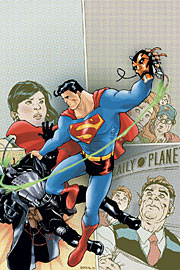 Writer Greg Rucka is the reason I became excited about reading comics regularly after a five-year hiatus (due in large part to his phenomenal run on Detective Comics). So, it’s only fitting that he’s the one that got me excited about comics’ greatest icon – Superman.
Writer Greg Rucka is the reason I became excited about reading comics regularly after a five-year hiatus (due in large part to his phenomenal run on Detective Comics). So, it’s only fitting that he’s the one that got me excited about comics’ greatest icon – Superman.
Over the past year, Rucka has quietly turned Adventures of Superman into the Superman title to read, the one both purists and newcomers look to as the Superman book of record. Being someone who favors more ambiguous characters like Batman and Green Arrow, I never thought that I would be so enthused about the “last boy scout” of the DCU. But that just demonstrates Rucka’s strength as a writer. It’s not that he’s done anything to change the character, quite the opposite in fact. By embracing his traditional core elements, Rucka has just made Superman relevant again.
The two most recent issues of the series (issues 640 and 641) collectively serve as an excellent jumping-on point for new readers. While Adventures of Superman # 640 is technically the conclusion of a previous storyline, involving the super-villain Ruin and a series of attacks on Superman’s allies, Rucka crafts the narrative in such a way that it effectively synthesizes much of the action of the past several issues, allowing readers to quickly get up to speed with what’s going on in the series. More importantly though, issue 640 is an insightful overview of Rucka’s philosophy on Superman and the character’s role in the DCU – the man that refuses to despair, the heart of the DCU. It’s quite inspiring to think about really. More than the invincibility, the super speed, or the ability to fly, what truly makes this character great is not necessarily that he fights to the finish, but that he refuses to despair. He never loses hope. Rucka captures that and, as hokey as it might sound to some people, truly made me reevaluate how I felt about the character. That’s great writing.
Though not the emotional powerhouse that issue 640 is, Adventures of Superman # 641 is certainly more plot-heavy and lays the groundwork for the next storyline, as a security failure at Styrker’s Island maximum security prison leads to the escape of several super-villains including Ruin, but not before he reveals to Clark Kent that he knows the reporter’s alter ego. Needless to say this raises the stakes for the Man of Steel as his worst fears materialize – that his enemies will continue to go after the ones he loves in the hopes of breaking his spirits. In that sense, issues 640 and 641 build nicely on the larger DCU-wide issues that were first raised in Identity Crisis and will continue to develop throughout the course of the year. In short, the heroes are being put through the wringer, and this is making for some great stories, not just in Adventures of Superman but across the DCU line.
Adventures of Superman # 640 also marks the debut of Karl Kerschl as the regular series artist, and I’m impressed with his work here. He has a kind of soft, rounded and inviting – very human if you will – style that I think is appropriately matched for this character, as well as a good eye for character detail, which helps Rucka get the most out of some of the more emotional moments. It’s not flashy, but Adventures of Superman is a nice looking book.
Adventures of Superman # 640 –
FIVE OUT OF FIVE VIKINGS

Adventures of Superman # 641 –
THREE AND A HALF OUT OF FIVE VIKINGS

Straczynski’s “Dream Police” One-Shot May Become On-Going If You Believe Hard Enough
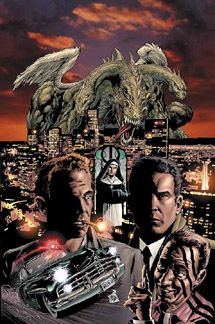 Are you familiar with the Jungian theory of the collective unconscious? If not, let me give you a gross oversimplification: Our buddy Carl believed that in everyone’s subconscious there are common touchstones. Whether you are a clog-dancing maid in the
Are you familiar with the Jungian theory of the collective unconscious? If not, let me give you a gross oversimplification: Our buddy Carl believed that in everyone’s subconscious there are common touchstones. Whether you are a clog-dancing maid in the
J. Michael Straczynski’s Dream Police is set entirely in Jung’s collective unconscious. In this fantastical landscape that looks remarkably like
The art by Mike Deodato (Amazing Spider-Man) is dark and heavy. The noir feel is a direct result of the locale and therefore not forced in the least. Deodato goes for a realistic style that contrasts very nicely with the fantasy elements. In this way, it’s quite a bit like Stefano Gaudiano’s work in Gotham Central. Although here we get a lot more detail.
As of this writing, Dream Police is a one-shot. And as is usually the case, if this title is popular enough a full-blown series might come to pass. I say bring it on! This is a series I could really get behind. So far Straczynski has only scratched the surface of what a couple of beat cops patrolling a realm of our dreams and nightmares would be like. I want more.
FOUR AND A HALF OUT OF FIVE VIKINGS

Pfeifer and Woods Show Grace and Agility in their First “Catwoman” Outing
 Show me a Batman-related title, and I’ll show you a book I’m likely going to read.
Show me a Batman-related title, and I’ll show you a book I’m likely going to read.
I know, I know, I’m a sucker—but what can I say? The exception I made for a long time was Catwoman, as the character held little interest for me until Ed Brubaker and Darwyn Cooke made me a believer. Following Brubaker’s departure, and with Paul Gulacy as a somewhat-questionable choice for artist, my interest waned to nil and away I went. Now, issue # 44 brings the new creative team of Will Pfeifer and Pete Woods and, in addition to being sold on their run, I’m fairly convinced that Pfeifer is one of the best writers nobody seems to give a damn about.
Being a big fan of his work on titles like Hero and Vertigo’s Finals, I even gave his Aquaman run a shot. Coming onto Pfeifer’s take on Catwoman with a degree of positive expectation, I do have to say that he didn’t wow me in his first issue. Largely devoted to establishing Catwoman’s position as protector of the East End of Gotham, Pfeifer has her get into tangles with jetpack-clad thugs and ventriloquist villains, all before kicking his plot into high gear. Using Hush as a major rogues player, he enlists Catwoman’s b&e expertise to retrieve something from STAR Labs for him. He offers her and her district a certain amount of immunity from coming criminal influence, and she gladly accepts to make life easier for her little corner of the world. The issue ends, then, with her break-in attempt which, in the interest of keeping the plot suspenseful, goes awry.
In short, Pfeifer delivers some standard super-hero goodness. Nothing wrong with that, in any way, shape, or form, but nothing particularly overwhelming about it, either. Just nice, standard stuff.
On the art front, Pete Woods is delivering some wonderfully crafted and rendered set pieces here. Far removed from his cartoony, Robin days, Woods is displaying a command of line and rendering that’s pretty stunning and, well, just plain pretty. Working with colorist Brad Anderson, the two are achieving a nice pop-flavored sensibility to the look of the book, with neither one of them working against one another.
A finely crafted, good looking book with room to spare on the writing, but a perfect jumping on point if you’ve ever been curious.
FOUR OUT OF FIVE VIKINGS

“Dead World” – Something New for the Zombie Lover in You
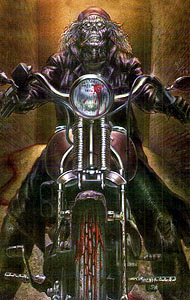 I feel about the new Image comic series Dead World much in the same way that I do about George Romero’s Land of the Dead. I like it. I don’t love it. But I’ll certainly be adding it to my collection. Zombie apocalypse stories are like bacon-cheeseburgers. They’re not filet mignon, but they’re yummy and they’re hard to get wrong. And like Land of the Dead, Dead World goes against the tried and true formula of “find supplies and shoot the stiff” by putting it’s own unique spin on (what is becoming) the zombie apocalypse genre.
I feel about the new Image comic series Dead World much in the same way that I do about George Romero’s Land of the Dead. I like it. I don’t love it. But I’ll certainly be adding it to my collection. Zombie apocalypse stories are like bacon-cheeseburgers. They’re not filet mignon, but they’re yummy and they’re hard to get wrong. And like Land of the Dead, Dead World goes against the tried and true formula of “find supplies and shoot the stiff” by putting it’s own unique spin on (what is becoming) the zombie apocalypse genre.
As the title suggests, the setting for this story is quite large, with numerous factions populating an expansive landscape. Aside from the standard “humans versus mall walkers,” there’s also a more advanced breed of zombie – undead but capable of all the functions of the living, including speech. Admittedly, at first I was put off by this idea, if only because it took me out of my comfort zone. But very quickly I came to appreciate the uniqueness of it and the change of pace, and it makes sense given the supernatural catalyst for the apocalypse. The more I think about it the more I like it because it adds a “Road Warrior” element to the standard template with a touch of Stephen King’s “The Stand” to boot.
The focus of Dead World # 1 is on a group of Catholic school kids who’ve hit the road in a school bus packed with guns in search of “Safe Haven,” mankind’s last rallying point. Along for the ride is an enigmatic recluse by the name of Deake, who may be the key to figuring out this whole mess, if he can stay alive long enough. On their tails is the merciless King Zombie, the Toll-Cutter if you will of the Dead World.
Dead World # 1 is an enjoyable read and I plan to continue with the series. Really the only complaint I have here is that there are a lot of players introduced in this first issue, and you don’t get to know any of them that well. Makes it kind of hard to care when one of them is ripped to pieces. Then again, that’s why it’s a series – and I assume with time the characters will be adequately…fleshed out (that’s right, I said it). Writer Gary Reed brings some things to the table here that makes for a fresh read and saves the book from just being Romero fan fiction, and artist Vince Locke’s raw and gritty black and white artwork is just fantastic.
As an aside, though I’m not one for “spoilers,” I recommend reading the writer’s notes at the back of the issue for a glimpse at the impressive scope of this story.
THREE AND A HALF OUT OF FIVE VIKINGS

Brubaker Fills in Readers New and Old in “Captain America”
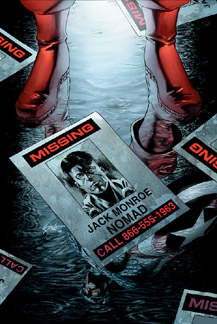 There’s a lost art to the fill-in issue that writer Ed Brubaker has reclaimed. As a student with many masters, the Fill-In issue has a difficult challenge: it has to buttress itself between major arcs of an ongoing series; it has to be an interesting jumping on point in the midst of an ongoing arc; it has to give the regular artist a month off; it has to keep the interest of the continuing audience; and it also has to tell a modular story, one that fits with the ongoing arcs as well as stands on its own.
There’s a lost art to the fill-in issue that writer Ed Brubaker has reclaimed. As a student with many masters, the Fill-In issue has a difficult challenge: it has to buttress itself between major arcs of an ongoing series; it has to be an interesting jumping on point in the midst of an ongoing arc; it has to give the regular artist a month off; it has to keep the interest of the continuing audience; and it also has to tell a modular story, one that fits with the ongoing arcs as well as stands on its own.
What it doesn’t have to do—though is nice when it does—is illuminate the ongoing arc in new and different ways. And it’s with issue # 7 of Captain America, in a story titled “Interlude: The Lonesome Death of Jack Monroe” Brubaker not only rises to the above challenge outlined, but perhaps succeeds and redefines how one can approach the Fill-In issue, both as a creator and a reader.
On the surface, this issue is pretty much as advertised. Brubaker steps us back a good seven or eight months when Jack Monroe—former sidekick to Captain America—is diagnosed with a degenerative condition that is unique to his super-heroey physiology and, likewise, incurable. Like most former-heroes would, Monroe decides he’s going to don the duds one more time and do whatever good he can in the remaining months he has. Only, because of his condition, he’s suffering from blackouts and mood swings, as well as a nasty cough that often includes blood. Also, he keeps seeing visions of Bucky in the mirror—the sidekick that predated him. All of this finally builds to a head when he’s about to take down a major drug trafficking ring, only to be shot and killed before he can, as Brubaker leaves us with an ironic coda.
Looking a little deeper—and, in light of the rest of the run—Brubaker seems to be tipping his hand a bit. With last month’s revelation about the identity of the new villain, the Winter Soldier, seeming to be a character long thought dead, the time to break that story to flesh out the quiet death of a longtime supporting character seems apt. (That revelation, by the way, I won’t spoil for you—needless to say, Brubaker’s crossing one name off of Marvel’s DNR list, really only leaving Uncle Ben and Gwen Stacy.) At the same time, there are hints and portents in this issue that not all we saw last month is quite as it seems, and it’s here that Brubaker accomplishes the unenviable task of making the Fill-In story feel important and relevant to everything else that’s been going on.
Art wise, it’s hard to argue with John Paul Leon’s rendering when you’re trying to make a story feel important and relevant. An artist of high caliber, Leon brings a fresh realism to the book—a nice contrast to the spy-book bravado of the title’s regular artist, Steve Epting. Fitting for Monroe’s more down-to-earth, psychological story, Leon’s linework is delicate and moody, and shows a great command of storytelling nuance and character acting. Brilliant.
Overall, if you’ve been wondering about Brubaker’s Captain America, this isn’t a bad place to start. It’s a sideways in to a wonderful psychologically driven spy-actioner, and Brubaker lays a lot of intrigue and suspense out in this issue.
FOUR AND A HALF OUT OF FIVE VIKINGS

Carey and Fabry Stay in the Shadows with “Neil Gaiman’s Neverwhere”
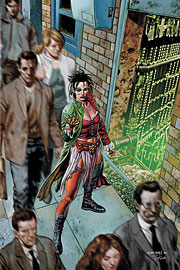 First, it was a BBC television mini-series. Then, a novel. Now a comic book mini-series.
First, it was a BBC television mini-series. Then, a novel. Now a comic book mini-series.
And you know all the Neil Gaiman fans have looked at it in each iteration. You know that, because I’m telling you that, as a card-carrying Gaiman Geek, who owns the novel. And the BBC DVDs. And now, the first issue of the comic book.
Neverwhere was Gaiman’s first solo foray into the world of novel writing, and the story combines what his fans have come to expect from the man: a whimsical, macabre real-world fantasy about things not being how they appear. It’s about what happens when London native Richard Mayhew meets Door, a girl from the other London, the London Below. As he will soon discover, this other London is populated with colorful people bearing fantastic powers and fantastic secrets. And it translates remarkably well as a comic book.
In the able hands of Mike Carey and Glenn Fabry, Gaiman’s story flows evenly from prose to comics, with Fabry keeping the visuals bright and popping, and Carey distributing Gaiman’s dialogue and narration in even, staccato bursts. Still not seeming to want to come out from Gaiman’s shadow, I find it odd that Carey would work to adapt Gaiman’s novel. Considering, however, that Carey’s Lucifer is not only a ripe spiritual successor to the six-hundred pound Sandman gorilla, but also that it’s one of the only Sandman spin-offs worth a damn, I imagine Carey considers the adaptation gig an honor. He does a good job though of pacing out the novel in a way that both makes sense and makes use of the differences in form.
Fabry is an artist whose work I always enjoy, even when I’m not enjoying it. A highly capable artist, Fabry has a real-world verisimilitude that works well for this kind of back-alley fantasy. Capturing the rugged, dirty flavor of London, while still keeping a sense that this is a world with wonders just around the corner is a hard task to manage. That, added to the fact that he has the unenviable task of bringing to life characters that have already seen three dimensions in the BBC production, or in the reader’s imagination, means that he has a lot to live up to. And, for the most part, it works: Richard is appropriately nebbish; the villains, Mr. Croup and Mr. Vandemar have an idiosyncratic sinister nature to them; and at the end, the Marquis de Carabas has an equally charming, weird foppishness. His choice of design for Door, however, strikes me as a bit odd—really, a keyhole tattoo over one eye? — but one that I’m willing to live with. Either way, kudos to Fabry on the art—looking a bit more dynamic than some of his more recent work, even.
Though a very entertaining read, I can’t help but be struck with the pointlessness of it. Were Gaiman fans really clamoring for the comic book version of a novel they’ve already read? I suppose if you’ve never given books-without-pictures a shot, having a comic book version of a good novel is worth your while, but if you’ve read the book, seen the BBC mini series, what you’ll find here is just another good take on the same material.
THREE AND A HALF OUT OF FIVE VIKINGS

McDaniel Finds His Niche Again with Willingham on “Robin”
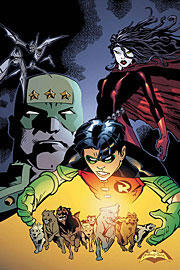 Poor Scott McDaniel. It seems, as an artist, he’s forever typecast.
Poor Scott McDaniel. It seems, as an artist, he’s forever typecast.
First gaining prominence in the early nineties on a frenetic, action-filled romp through Daredevil, he switched sides and gave a stellar run on DC’s Nightwing. From there, he graduated to Batman, and then made a lateral move to a poorly received (though, in my estimation, actually pretty good) run on Superman. Since then, he’s been in the trenches with Richard Dragon, a title nobody gave a damn about and it was a shame, and now he’s back in the relative warmth of the Batbooks again, this time joining writer Bill Willingham on Robin with issue # 139.
You know what, though? For an artist that seemed for a short while to want to get away from the urban, crime-fighter book, he does a damn-good job on it. Fitting Willingham’s take on the young vigilante, as well as providing the book some much-needed artistic stability, their first issue together takes us through a nice in-one-issue adventure, as well as establishing Willingham’s new direction on the book.
Storywise, this Robin, Tim Drake, is finally an orphan, thanks to recent Bat-crossovers and Identity Crisis. As such, he’s finally that much closer to being like Batman, and in recent months found himself being cared after by a long lost uncle. The first few pages resolves that particular thread—in a scene that had me giggling for how Willingham suckered my expectations—and leads us in a new direction, involving a different kind of mentor for Robin, the Veteran. A kind of “Captain America-lite”, the Veteran is purported to be a mythic representation of the American soldier, and this issue’s story serves nothing more than to bring Robin under the Veteran’s tutelage. The new direction promised by Willingham, then, is a new mentor for Robin, and a possibly divided loyalty story, which should make for some interesting fun.
With McDaniel coming on board, the story wisely reads well, assuming you’ve never picked up a Robin comic before. McDaniel does what he does best, which is inventively staging an exciting action scene, full of kicks, punches and twirls. Not to be outdone in the talking heads department, McDaniel shows his chops there, as well.
All in all, a completely inoffensive super-hero book, and one that you would do well to give a look-see if you’re curious.
THREE OUT OF FIVE VIKINGS

So ends this accounting of valiant warriors and high adventure! Return next week to honor (maybe) SOLO, Young Avengers and Planetary. Praise Odin.
To discuss this column and all things Nordic, you may contact Sean at scfahey@yahoo.com , Devon at thedevonsanders@yahoo.com , Dave at dave@chud.com , Russell at inadvertent@mail.com , Rob at poprob@gmail.com and Graig at graig@geekent.com.
HAVE A COMIC YOU WANT TO SUBMIT FOR REVIEW? Contact Sean at scfahey@yahoo.com.